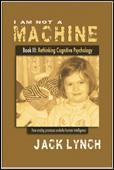|
Here are a few questions that the books address.
Can animals think? is a deep question because it compels
us to be quite specific about what we mean by thinking. I argue in Book
I that animals can indeed “think” but that to characterize
what is going on we need to understand how animals represent the physical
world they live in. Shedding our anthropomorphic metaphors about thinking
is a major challenge that Book I addresses because it requires us to
develop new ways of modeling cognition.
Below you will find the following general information: General Introduction Most people associate human thinking with language. If I ask you what you are thinking about you might say that you are thinking about a party you went to on Saturday. That is, you readily answer my question with words and there seems to be a seamless divide between however your thought was represented and how you expressed it. Some would conclude that human thinking is intimately tied up with language. Language and mind, from this perspective, are in some sense the same thing or at least are married for life. However, there are others, say outraged musicians, architects and artists who proclaim that they think without words. Thinking without words is also the idea that underlies some people’s beliefs about animal cognition. Such nonlinguistic thinking could be a link between animal thinking and human thinking. This line of thought leads us to ask about mental representation. Do we represent the world round us in images or words? Of course, I don’t mean how you consciously represent the world because most of us can dredge up sounds, smells, pictures and words to subjectively recall some experience. The deep question has to do with subconscious or rather non-conscious mental representation. This, in turn, raises the question of how can you possibly study that! As a friend of mine loudly exclaimed, How can you possibly know what my dog is thinking? My answer is to ask you how do you know that the moon is not made of green cheese? You’ve never been there. We know most things about the world by indirect means based on a complex web of beliefs. Some people call it science, but most people just sort through a myriad of stories to find a coherent set of ideas that are partially supported by experience and partially supported by things they hear from people they trust. In other words, it’s not going to be easy to understand human intelligence and primate intelligence because it’s going to be necessary to learn about a whole new way of describing mental functioning. Our concern will not be the content of thought but rather how thought works. But not to worry, it’s actually fun to think about thinking. That is why I wrote a book about it called, I Am Not a Machine. Back to top For the insatiably curious, I have included some other information on this web site. For the Pet Owner describes how people who love animals might be best served by reading some other books first. I Thought you’d never ask tells you something about my past in order to explain how I got involved with cognitive studies and how it is that I have such singular views. Reviews of Other Books in the Field is a personal annotated bibliography. My goal is to explain how I found a particular book useful and meaningful. Contact gives you a vehicle for writing me a short note. Unless I am overwhelmed with responses, I’ll do my best to respond to you. And thank you for taking the time to read about my ideas.
Back to top Home I
Annotated Bibliography I For
Pet Owners I Thought You'd Never Ask
I Contact |
Click on the cover image for more information about the corresponding book.
Amazon.com
Buy the Book... Amazon.com Buy the Book... Amazon.com
|
 I
Am Not a Machine
I
Am Not a Machine

